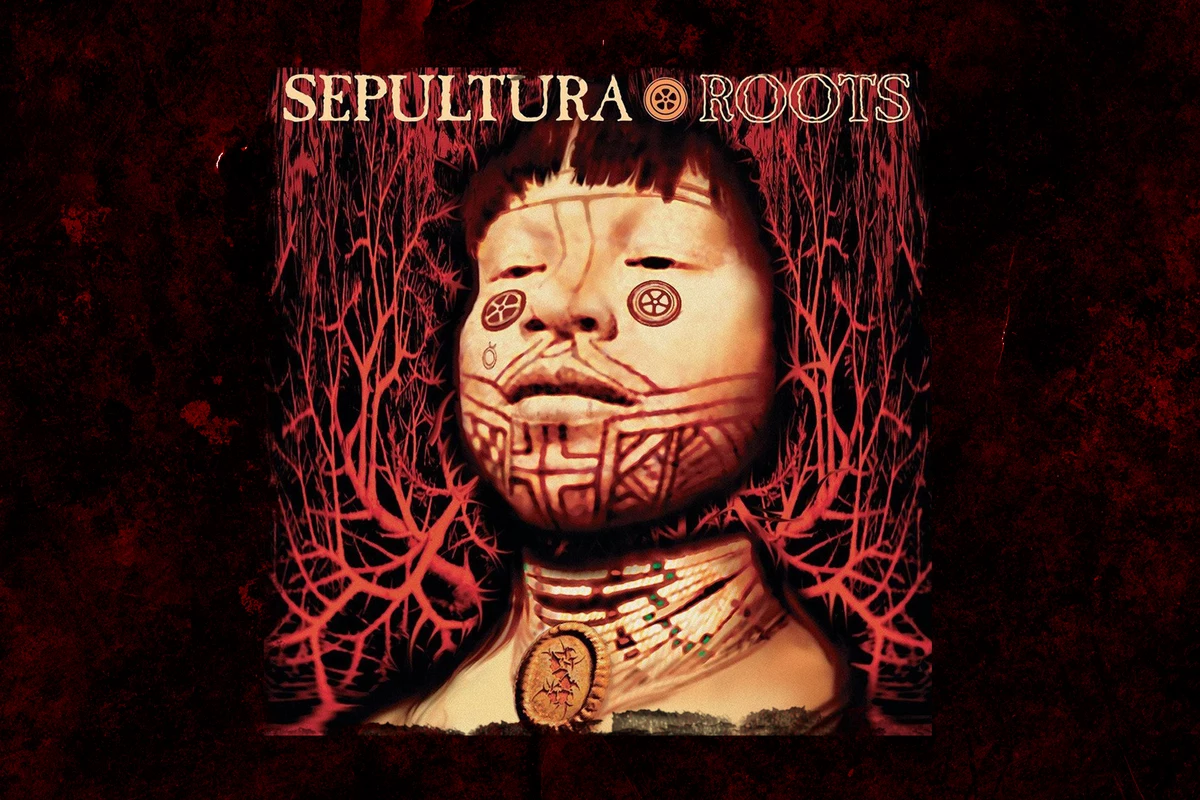
“I say we’re growing every day / Getting stronger in every way / I’ll take you to a place where we shall find our roots!!!” screamed Sepultura vocalist and rhythm guitarist Max Cavalera in “Roots Bloody Roots,” the opening track on the band’s sixth album Roots, which came out Feb. 20, 1996.
The lyric was more than a boast, it was a statement of purpose. Sepultura had previously explored their Brazilian heritage on the acoustic track “Kaiowas,” from 1993’s Chaos A.D., and the vibe they got from the groove of the song was a wakeup call. “Kaiowas” featured tribal percussive exchanges between drummer Igor Cavalera and bassist Paulo Jr and acted as a template of sorts for Roots.
“We decided to do an album that expanded what we started on Chaos A.D.,” Max Cavalera told me when the record came out. “We had already used this unusual percussion with heavy music, and it worked out really well so we thought we could do more with it. That’s why we brought Brazilian musician Carlinhos Brown into the scene. He’s a mad, magic kind of guy.”
Sepultura originally invited Brown to join them at an MTV Brazil concert appearance in 1995, and for the final song of the set, “Kaiowas,” numerous musicians, including Brown, picked up a drum and played together.
Sepultura on MTV Brazil
“At the end of the show I knew Carlinhos was the man for Roots,” Cavalera said. “And once we had a drummer we could look for an actual tribe that could make the record an even more authentic mix of heavy music and Brazilian culture. For the last eight years, everyone was asking me when our roots were gonna really show up in our sound. Nobody’s going to listen to this record and think we’re from L.A.”
After reaching out to a cultural center of indigenous music Sepultura were able to contact the Xavante Indian tribe, which lives in the remote jungles of Central Brazil. When they first met the tribe’s chief, Cavalera picked up a powerful spiritual vibe. The Xavantes wanted to hear a sample of Sepultura’s music, so the band played them “Kaiowas” as they had done it for the MTV show in Brazil.
“When we finished it they started talking to one another and we couldn’t understand anything they were saying,” Cavalera said. ”But the chief spoke a little Portuguese and he said they liked it and wanted to hear it again. So we played it again. That was probably one of the most intense audiences we’ve ever played for because it was a different kind of audience; it was 200 Indians just sitting down and listening.”
Mick Hutson, Getty Images
Mick Hutson, Getty Images
For the actual recording session with the Xavantes, Sepultura did 15 takes of two different songs, “Itsari” and the 13-minute-long bonus track “Canyon Jam.” “We just kept playing and in the end we used the best recordings we had,” Cavalera said.
“The experience was amazing, but it was also weird. We were covered in mosquito bites because even thought we had got this special repellent before we left, it didn’t work for shit. Also, there was no electricity so we had car batteries hooked up to the recorders. The problem with that was we couldn’t play stuff back because there wasn’t enough juice. So we did 15 takes and just prayed that anything we did got recorded.”
What got recorded helped define the spirit of Roots, but there were also other factors that contributed to the creative vibe of the record. Since releasing Chaos A.D., Cavalera had been arrested twice – once in Brazil for defacing the country’s flag by superimposing a big ‘S’ on it and then displaying it in concert – and again in Phoenix for getting into an altercation with some locals.
“My wife and I went to see a Rage Against the Machine concert, and as we were getting out of the concert to go home a jeep full of jocks started to give us shit,” he recalled. “I screamed , ‘Fuck you!, and they came back with guns, and shot at us. I got really freaked out because my wife was pregnant, and then I was trying to protect her. The police heard the shots and showed up. They grabbed my passport, which was Brazilian, and they said, ‘We’re gonna deport you, motherfucker.’ I explained that these guys had shot at us and it was like talking to a wall. The cops ignored me and came up with their own story. They blamed us and let these asshole jocks go. We spent 18 hours in jail and the whole time I was thinking, ‘When I get out of here I’m going to write so much hateful shit. ’Straighthate’ is very personal, hateful song. Perhaps the most hateful I’ve ever written. It’s about being fed up with all the people that put you down for what you are, and then accepting you and stuff. Kiss your ass or something. That kind of shit makes me sick.”
Sepultura, “Straighthate”
“Sick” is an accurate description for the tribal groove and boiling hate that comprises Roots. “Attitude,” for instance, opens with the exotic sounds of a Brazilian one-stringed instrument called a Berimbau which segues into a storm of guitar feedback and tribal percussion before bursting into blaze of rhythmic rage. Throughout, Roots is unrelenting, filled with experimental flourishes, but packed with so much anger and aggression that the adventurous passages only enhance the aggression.
In addition to working with the Xavante tribe and Brown (who contributed to “Ratamahatta,” “Dictatorshit” and “Endangered Species”), Sepultura enlisted some friends to help write and perform, including Faith No More vocalist Mike Patton, Korn singer Jonathan Davis, ex-Korn drummer David Silveria and Limp Bizkit’s DJ Lethal.
“It was kind of like a big jam album for us,” Cavalera said. “We brought all these guests, we wrote songs in the studio. We never did that stuff before so it was more fun, adventurous and unpredictable.”
While Roots could hardly be considered a nu-metal album, it shares more than just a few of the subgenre’s band members. Songs lunge and bite like early Korn and the album was actually produced by Ross Robinson, who helped sculpt early efforts by Korn, Limp Bizkit and Slipknot. Sepultura started tracking the album at Indigo Ranch in Malibu, California in October 1995 and finished about two months later.
Sepultura, “Roots Bloody Roots” Music Video
“It’s an angry, weird album that incorporates so many different kind of things, “Cavalera said. “It really has its own identity and I don’t think we could ever repeat this album again even if we tried.”
Roots debuted at No. 27 on the Billboard album chart and was certified gold by the RIAA on Nov. 16, 2005.
Considering how forward-thinking Roots was, it would have been amazing to hear what Cavalera and his band mates could create for a follow-up. Sadly, that never happened. In 1996 Cavalera quit the band after the rest of Sepultura announced they wanted to work with a new production and management team. That would have meant ousting Cavalera’s wife/manager Gloria Cavalera, which caused a 10-year feud between the Cavalera brothers that only ended when they formed Cavalera Conspiracy in 2007.
“I felt like they were biting the hands of people that fed us, you know?,” Cavalera said. “These people put themselves on the line for us. Gloria worked for us for two years without earning one dollar, man, just for the passion of the music. So I said, ‘If this is how it’s going down, I’m out. I can’t do it. I can’t just put a mask on and go do what I do knowing that I backstabbed a bunch of people that trust me.’ And just for the fact that Igor came back to me, that was proof that they were wrong and they shouldn’t have done that and we should have stayed as we were with the people we had because we were doing good. Why change things when they’re good?”
Loudwire contributor Jon Wiederhorn is the author of Raising Hell: Backstage Tales From the Lives of Metal Legends, co-author of Louder Than Hell: The Definitive Oral History of Metal, as well as the co-author of Scott Ian’s autobiography, I’m the Man: The Story of That Guy From Anthrax, and Al Jourgensen’s autobiography, Ministry: The Lost Gospels According to Al Jourgensen and the Agnostic Front book My Riot! Grit, Guts and Glory.
Top 90 Hard Rock + Metal Albums of the 1990s






















![Moneybagg Yo – PLAY DA FOOL [Official Music Video] Moneybagg Yo – PLAY DA FOOL [Official Music Video]](https://i.ytimg.com/vi/q5y5HHUwfBs/maxresdefault.jpg)
![Cardi B – Like What (Freestyle) [Official Music Video] Cardi B – Like What (Freestyle) [Official Music Video]](https://i.ytimg.com/vi/GcNC7YnlhKc/maxresdefault.jpg)
![Quando Rondo – Grow Up [Official Music Video] Quando Rondo – Grow Up [Official Music Video]](https://i.ytimg.com/vi/8zFnCg3BO4Q/maxresdefault.jpg)